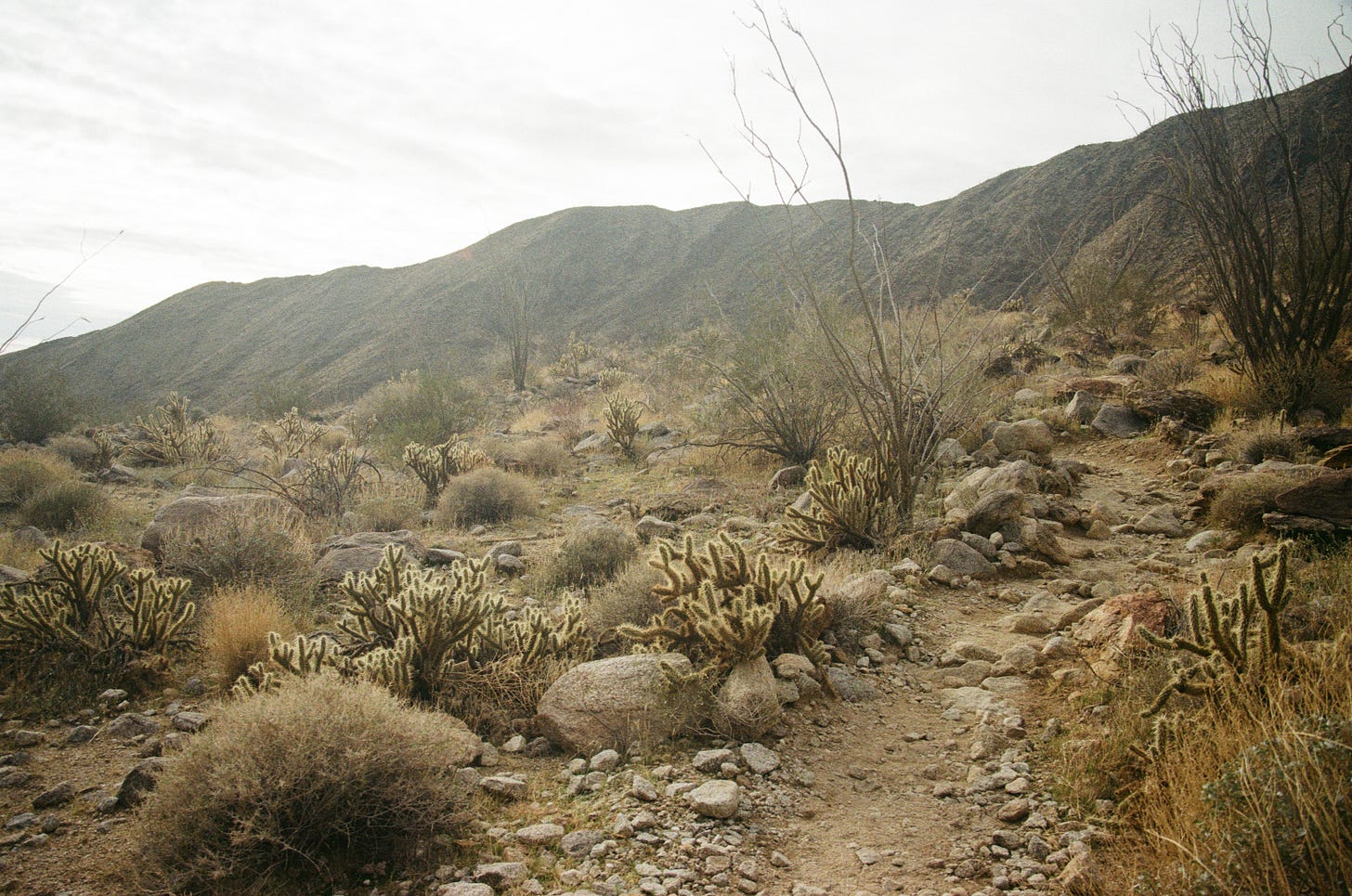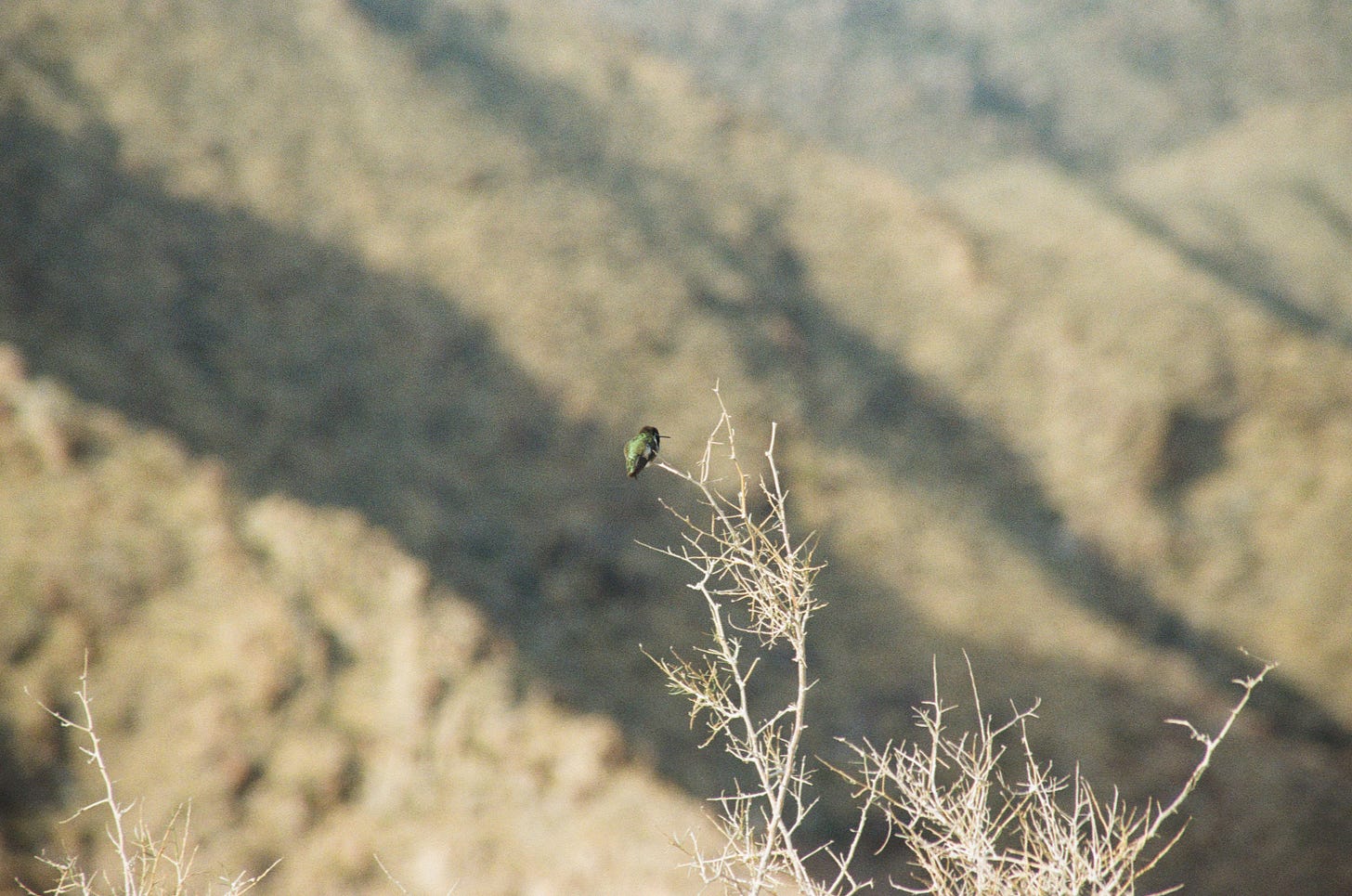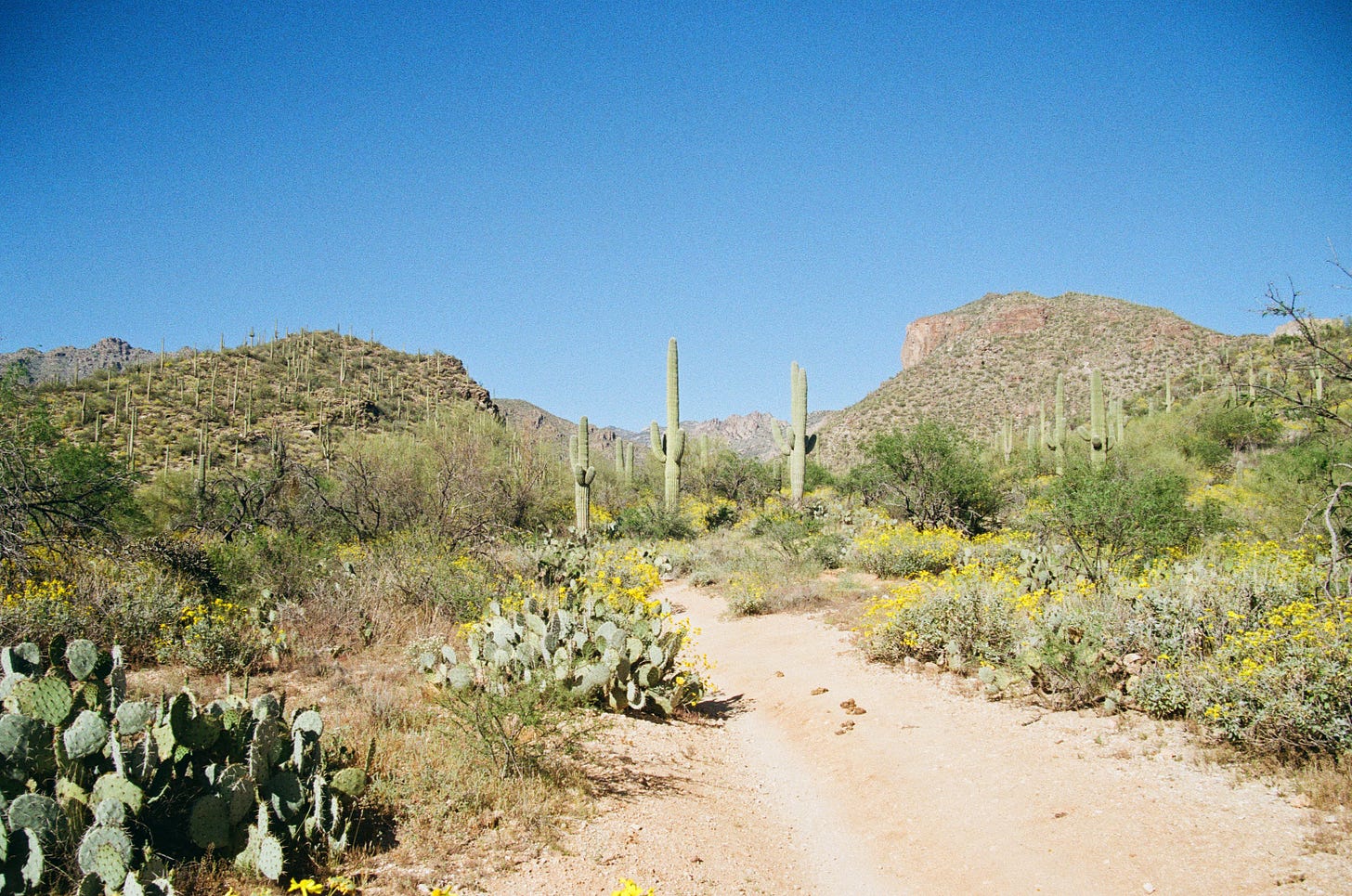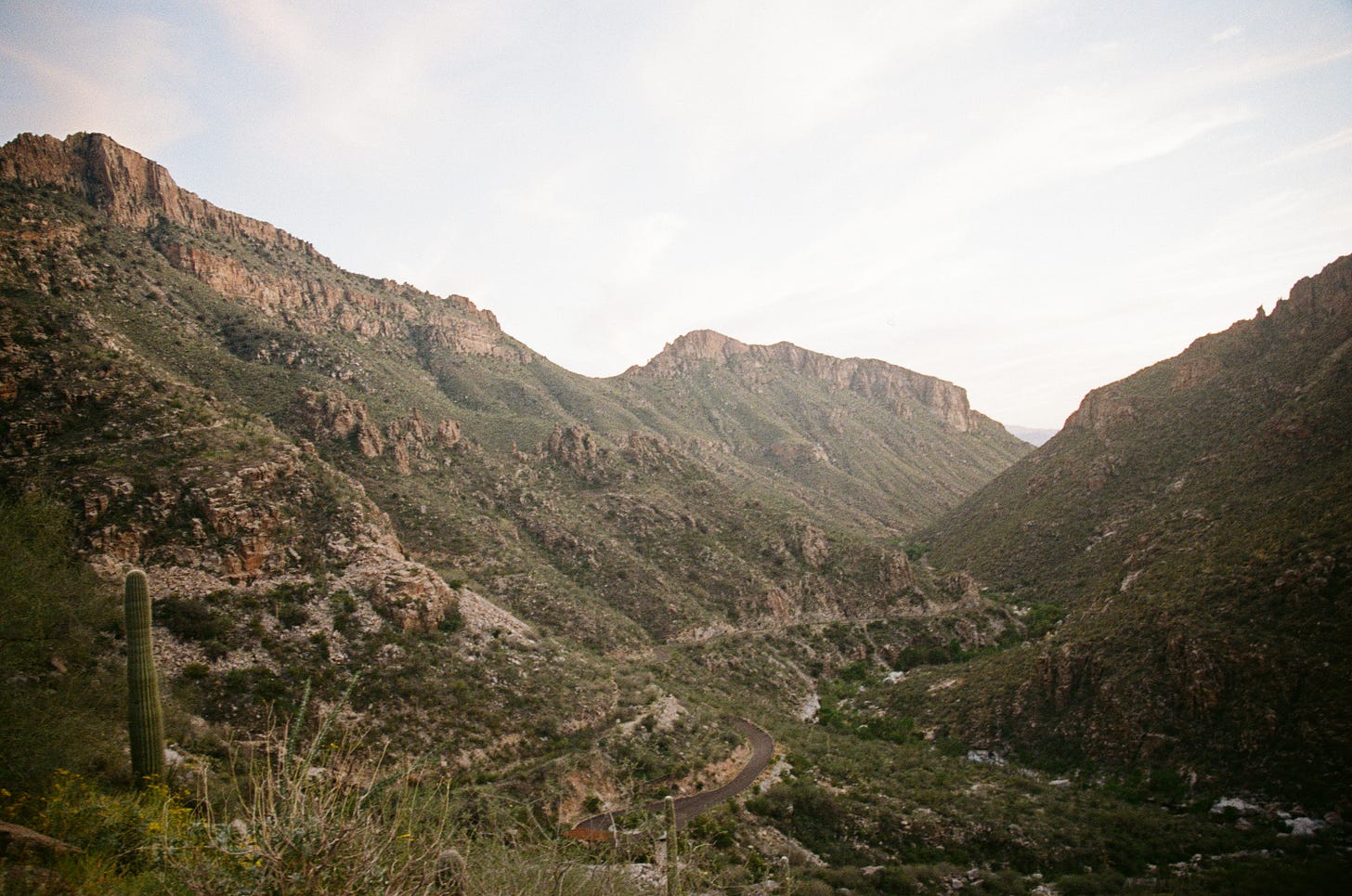Entry 6 – An Ode to a Desert in Peril
“I am not an atheist but an earthiest. Be true to the earth.” ― Edward Abbey
In the cool predawn air, there is a moment in the desert, like a brief inhalation, that precedes a predictable, and yet wholly unlikely flurry of activity. When we think of the desert, perhaps we most often imagine a series of yellows, oranges, even reds, in the form of sweeping plains of sand or towering piles of rock. In this predawn moment, however, there is an unmistakable tinge of blue upon the world: the sky is a deep navy, just beginning to lighten in the east, and the very air itself pulses in a sort of underwater glow. Cacti and strange, straggly bushes push upwards from the sandy earth and the experience is not unlike wandering calmly through a deep blue coral reef. In that predawn moment, the desert and its inhabitants take a strong breath in and a slow breath out, calming themselves for the vicious onslaught of the sun as it treads its perilous path across the endless sky.
During this brief window, before the sun makes all but the lightest movement unbearable, the animals of the desert wake up and accomplish whatever it is they need to do before hunkering down in the shade for the day. The variety of bird life is staggering: Gila Woodpeckers, Western Meadowlarks, Grackles, Curve Billed Thrashers, Hummingbirds, Albert’s Towhees, Red Tailed Hawks, Kestrels, even Barn Owls flit around, calling, swooping, hunting, gathering nest material in a frantic hum of activity before the sun arrives to quiet the crowd.
Over the last year, I’ve had the immense fortune to explore the vast Sonoran Desert in Arizona, a place where life is so tenaciously vibrant, it amazes with its beauty and activity in such a seemingly barren place. During that wonderful hour of activity, I pinch myself in disbelief that I’m getting paid to wander these lands.
And while the desert is quite barren, from a plane or a high mountaintop perhaps, once you are among the cacti and the shrubs and the flowers, you are amazed to find that an entire world exists here and that it is, in fact, more vibrant and alive than you could have ever imagined.
Other writers have written at length about the desert; I am not the first, nor will I be the last, nor do I think I yet have any kind of unique insight into its mysteries. Interested readers should check out works by Edward Abbey (in particular, Desert Solitaire) and Craig Childs (in particular, House of Rain); these are folks who have spent countless hours wandering about in the desert for no other reason than the insatiable pull towards desolation. They both write beautifully and insightfully about the land, the people that inhabit (or historically inhabited it), and the non-human creatures that call the desert home. So while I am not the first to write about it, I confess to feeling the same pull whilst wandering about in the desert. There is something about the emptiness that just makes me want to write. Perhaps it’s the very sky, so vast, so open, so empty, that invites me to fill it with words, descriptors, run-on sentences. Or it’s the majesty of the flora that cling to life in the most desperate of situations; towering Saguaro cacti, hundreds of years old, reaching their many prongs towards the blue expanse. Or perhaps it’s the way the desert preserves everything: in a land so devoid of rain, there are few elements that can wipe away impressions of the past. Animal tracks, scat, bones, ancient human artifacts, everything is right there on the surface, just waiting for you to stumble upon. Walking around the desert in the cool dawn, spotting birds, old puma tracks, feeling the wind, looking at the cacti, I challenge you to not feel inspired.
I am beginning to learn the Sonoran Desert, its plants, its birds, its insects, but I am standing on the proverbial tip of the iceberg; I have only begun to unravel the secrets that the desert holds. It is a wonderful mystery to discover, life in a land so inhospitable. At the center of this mystery is one key element: water. Without water, there would be no life, we know this, and yet water itself is so hard to know in the desert: rarely will you come across it out in the open. It is truly incredible to see so many resilient plants and animals living in balance without any obvious traces of the lifeblood of our planet, water.
And it is this very reason that wandering around in the modern Arizona desert, in particular the regions around the mighty urban sprawls of Phoenix, Scottsdale, and Tucson, can be a highly disturbing experience. My most recent work has taken me to the very edges of this sprawl, conducting invasive plant surveys alongside the Central Arizona Project (CAP) Canal, a 300+ mile long monstrosity that transports water from the Colorado River to the valley, supplying farms and cities with fresh water.
The topic of water management in the American Southwest is not a particularly new concept; it is no secret that Arizona, Utah, New Mexico, and even Southern California are in deep trouble when it comes to water security and scarcity. But nowhere, in my opinion, is this trouble so evident than in the valley of Phoenix. It is highly disturbing, to say the least, to be wandering around in a parched creosote flat, so dry that the very earth is cracking and the creosote themselves, the most drought resistant and tenacious shrub in the desert, shrivel and collapse into dead sticks in the unrelenting heat. You wander through these dying desert plains and walk a quarter of a mile to see an alarming sight: a massive blue river, locked in concrete, diverting water from the mighty Colorado to distribute to countless new housing developments, enormous farms, swimming pools, and golf courses spread across the valley. It is truly maddening to one minute be walking in a dying desert, and the next to be driving alongside multi-million dollar, cookie cutter housing developments, where the entrances are coated in green grass and decorative fountains propel water high into the air before crashing down into massive human-made lakes.
In fact, I hope I’m not coming off as too extreme here, but nowhere else on Earth, except maybe in the presence of a strip mine or a logged old-growth forest, is the ecological destruction and tragic mismanagement of our planet’s resources more obvious to me than in the desert of the Phoenix valley. Central Arizona, unfortunately, is one of those places that feels so hopelessly buried under decades of human error and greed that the only suitable course of action must be the mass exodus of all its inhabitants and the destruction of the infrastructure that got us into this mess in the first place.
This is too extreme, of course. And I’m not really suggesting that the millions of people that call central Arizona home should pack up and leave, or raze the impressive society they’ve built in the desert. But people are going to have to think very carefully about how water is going to be managed in that region. And they’re going to have to do it soon: the Colorado River Basin, largely due to climate change and excessive water use by the 7 states that depend on it, has been in a historic, 20 year drought that threatens the very existence of the people that depend on it. Most of the water in the Basin (75-80%) goes to agriculture, and in Arizona, the most common crops are Alfalfa and Cotton, both very thirsty plants. Experts predict that in the next decade, Arizonites will have to shift very consciously away from water intensive activities including agriculture, golf courses, personal swimming pools, etc. Experts also predict that people may have to rely on more creative ways of consuming water including drinking treated wastewater and expensive desalination treatment, which leads to a host of other environmental and health problems.
To me, it seems far simpler to conserve water by removing all of the golf courses, personal swimming pools, and strictly limiting cash crop agriculture. But of course, this is an unpopular opinion as it would greatly threaten the precious bottom-line. Another complicating factor is indigenous rights: roughly 60% of farmers in Arizona today are indigenous peoples. It would be ridiculous for the American authorities, who have spent generations limiting indigenous activity and intentionally destroying livelihoods, to block this important flow of income to a very underrepresented group of people. But something has to give. The Colorado River, due to complicated arrangements between many interested parties during the construction of the dams that provide water to the region, is critically over-allocated, meaning there is not enough water in the river to meet the allocation demands.
Additionally, the issue is complicated, as always in this country, by politics. Most folks who are being critically impacted by this change, farmers, identify as conservative and vote Republican. This despite the fact that their party consistently downplays the effects of climate change and supports aggressive expansion of profit over every other factor. This irony is not lost on farmers, but they aren’t about to change their voting habits either. Under the current administration and the historic Inflation Reduction Act, farmers are incentivized to farm more sustainably and support conservation measures, with a 20 billion dollar budget allocated to this cause. Yet the Republican party is determined to reduce or destroy this initiative, at the peril of Arizona’s water and its farmers.
Did I mention Phoenix is the fastest growing city in the country (2020 census)?? Yes, despite temperatures soaring past the 100s for 100 straight days this year, despite water levels reaching historic lows, despite all of these factors likely getting worse in the coming years due to climate change, people are still flowing into the Valley of the Sun. Driving around Phoenix is an intensely overwhelming experience: everywhere you look the desert is being bulldozed in favor of hideous and enormous housing developments and equally massive factories to entice the new residents in the state.
I have no problem with people living in the desert. As I hope I have illustrated, life in the desert is beautiful, full, enriching. But the desert shouldn’t have to conform to our human desire for convenience and comfort. People living in the desert should conform to its conditions, not the other way around. This is going to mean hard work on the part of all interested parties in the Valley. It’s going to require cooperation among several different groups (and political parties) and above all, it’s going to require a certain flexibility in the average Arizona resident. You want to live in the desert? Fine. You can’t play golf, and you can’t have a swimming pool. You can’t farm acres and acres of water intensive crops. You can wake up early, explore the wonder, and enjoy the splendor of a truly incredible place, a place that desperately needs help. Arizona, and in particular, the Phoenix region, has been fucking around for decades. And now they’re going to find out. I just hope that it won’t come at the expense of an entire ecosystem.
This blog has been, in the past, mostly about my own adventures and experiences, so this environmental rant is probably a surprise for some readers. But as I advance into the field of wildlife biology and general ecological conservation, my own experience is tied directly into the management of wild spaces and crucial resources. I’ve had incredible wildlife experiences in Arizona and have immensely enjoyed most of my time there. But having spent the past couple of weeks in the Phoenix area and witnessing firsthand the destruction and reckless mismanagement of the desert’s most precious resource, I felt compelled to say something about it on my little platform here. This blog is largely about the exploration of natural spaces, and natural spaces everywhere are in grave danger. I hope this read was informative in some way. Rest assured I have done my research here, but I would love to chat with anyone who has a different perspective on the issue. To all of those living outside the Southwest, this may not seem like a big deal to you. But this region is where the majority of produce is grown in the US (which I disagree with as well, but I won’t get into it) and agriculture is a massive industry here, employing thousands of people. This water crisis will affect everyone, in some way or another, so I would encourage all to stay informed, and where possible to vote for change. Anyway, have a great weekend! I’ve got a new roll of film in the works, so you’ll be hearing from me again sometime in the near future.
Until next time,
Asher
Sources:
Bustillo, X. (2023, May 18). Arizona’s farms are running out of water, forcing farmers to confront climate change. NPR. https://www.npr.org/2023/05/18/1176657700/arizona-farms-running-out-water-farmers-climate-change-colorado-river
City of Phoenix Census, growth and development. City of Phoenix. (n.d.). https://www.phoenix.gov/pdd/planning-zoning/phoenix-statistics-and-census-data#:~:text=Phoenix%20is%20Officially%20America’s%20Fatest%20Growing%20City.&text=Phoenix’s%20population%20grew%20from%201.4,according%20to%20the%20Census%20Bureau.
Faller, M. B. (n.d.). The future of water in Arizona. The future of water in Arizona | ASU News. https://news.asu.edu/20221115-arizona-impact-future-water-arizona







Loved this!
beautifully written and informative. thanks, ash